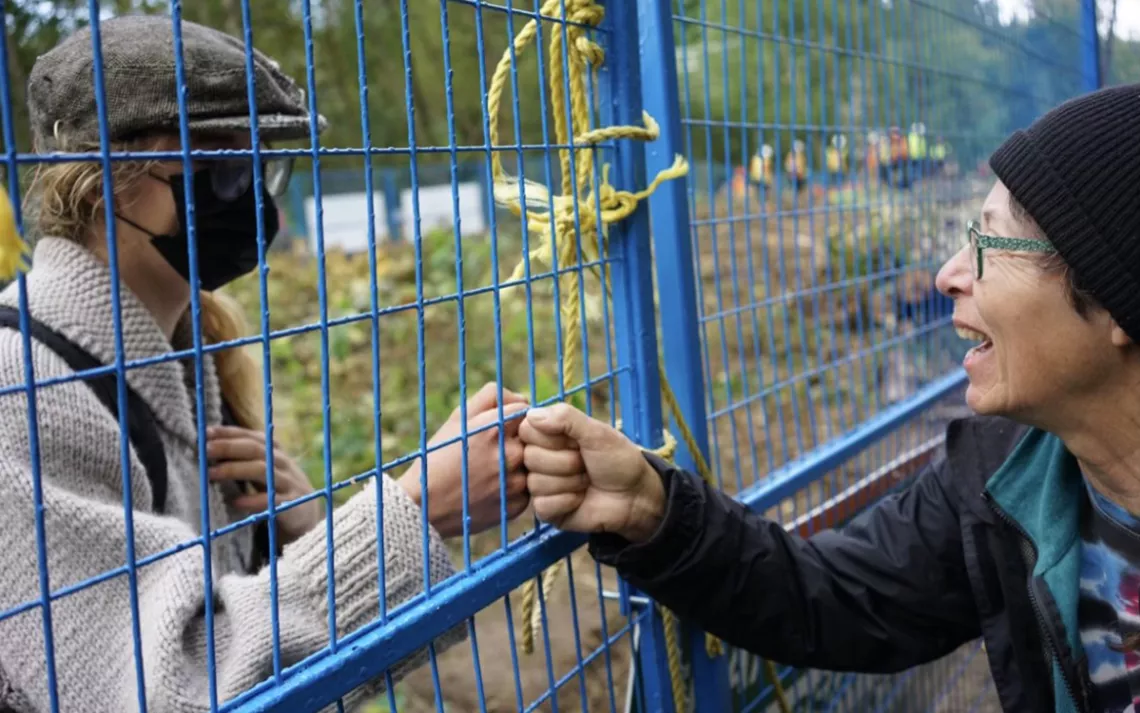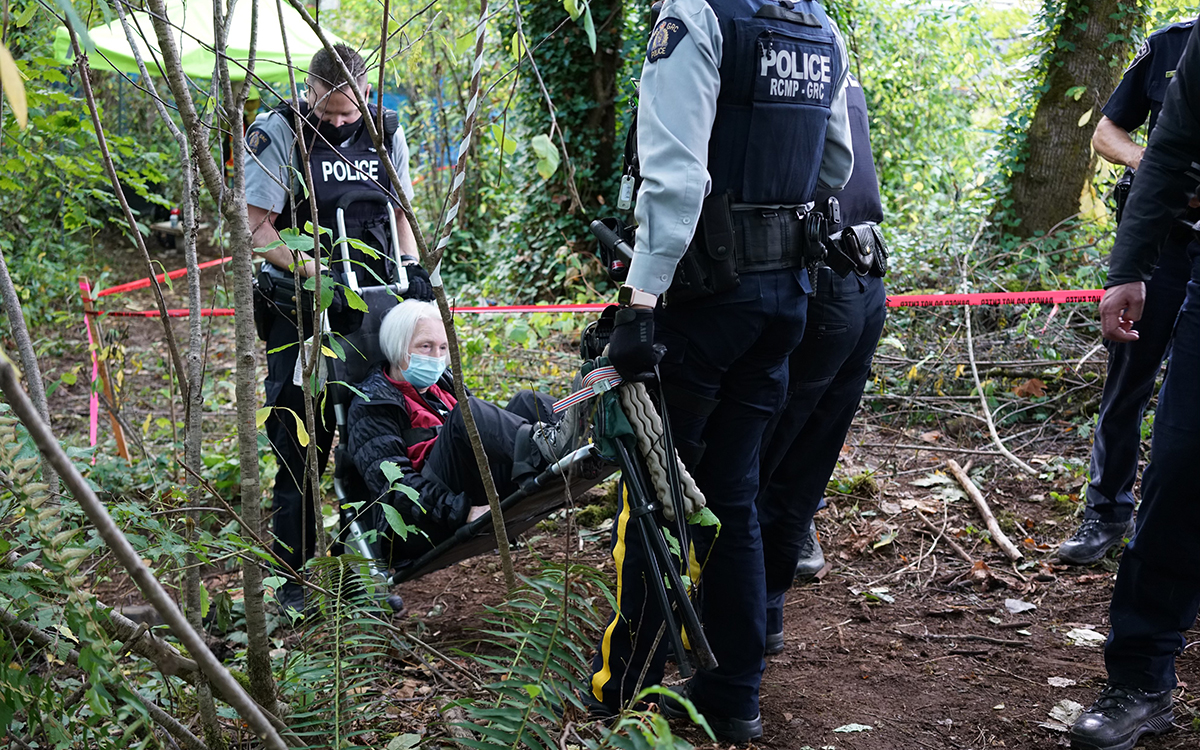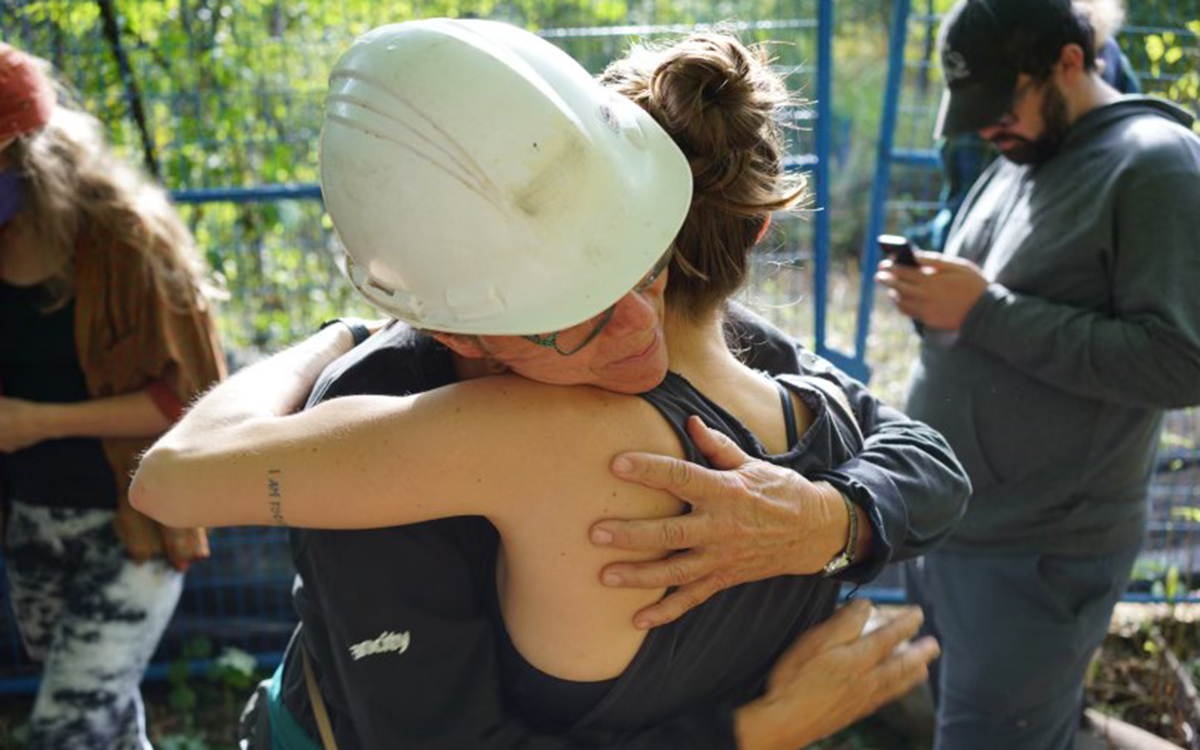Letter From the Treetops
What it’s like to block a 590,000-gallon-a-day oil pipeline from 50 feet in the air

A fist bump exchanged through a fence meant to keep activists out. | Photo courtesy of Robert Moor
The opinions expressed here are solely those of the writer and do not necessarily reflect the official position of the Sierra Club.
My palms were sweaty; my heart was pounding. On Thursday, September 23, I was perched with my friends atop a cottonwood tree. From our vantage point, it looked like this was the end. For the past two weeks, workers constructing the Trans Mountain Expansion (also known as TMX) Pipeline had been steadily advancing on the two treehouses that climate activists had been occupying for the past year.
Two days earlier, specially trained police working with Trans Mountain had extracted a climber nicknamed Big Bird, who had been living in a hammock at the top of a tree for over a week, and arrested him. He had been the last thing standing between our treehouses and the Tank—an enormous, white cherry picker used to lift up TMX workers and take down trees.
As the Tank inched into the forest, workers were picking off the trees one by one. Now that Big Bird was gone, we were the next thing on the chopping block. When the Tank got close enough, workers would be lifted in the bucket would and would cut off limbs from the trees with chainsaws. Regular police couldn't arrest us, but once a group that was specially trained to extract tree-sitters got here, we faced arrest. I had been preparing myself for this since the night before. Now the moment was here and I hardly felt ready.
Two years ago, the Canadian government announced that we were facing a climate crisis. The next day, it bought the TMX pipeline, a project which would almost triple the existing flow of tar sands oil to foreign markets, from 200,000 gallons a day to 590,000. Kinder Morgan, the pipeline’s original owner, and its shareholders were doubtful TMX was viable following legal challenges from the Squamish Nation, Tsleil-Waututh Nation and Coldwater Indian Band as well as environmentalists. The government purchased the pipeline to reassure investors and ensure that tar sands oil would make it to market, whatever the cost.
When I heard about the purchase I was reproachful but unsurprised. Long gone were the days where I could be reassured when my parents said things like “The government is going to take care of it.” I didn’t need to be a scientist to smell the smoke in the air or feel heat on my skin. The opportunity to alter our future for the better is rapidly closing but my government had once again demonstrated a critical lack of creativity and leadership. So, I sought out the company of those who had both traits in abundance. During an Extinction Rebellion protest, I heard about a tree-sit that was seeking volunteers.
In August 2020, Dr. Tim Takarao, a professor at Simon Fraser University, climbed a tree that was blocking the pipeline’s route. This caught the attention of a fearless young Quebecois tree-climber named Timothee Govare. A month later, he and a group of rag-tag hooligans began constructing a small kingdom of treehouses among the foliage ahead of the pipeline’s path. The first treehouse, Eagle, was taken down by RCMP (Canada’s national police) before it could be fully occupied, but two more sprung up not long after. Hummingbird was built atop a maple tree, and Blue Jay stood high in the branches of a tall cottonwood. The two were connected by a precarious hand-crafted rope bridge, and surrounded by dozens of other trees decorated with banners, and connected by climbing rope.
The rope ladder | Video courtesy of Emily Kelsall
In January, I reached out to Timothee. After being vetted (I had to provide two references), I began taking shifts in the treehouse. Visiting in the daytime was relatively easy; supporters could walk along the highway and out to the site without being bothered by TMX employees. At night, it was an entirely different story. That's when climbers would make their way to and from the tree. If TMX security found a climber on the ground, they could hassle us, cut our rope, block us from returning to a tree, or cut to the chase and call the police. By necessity, I became intimately familiar with the patch of green we were protecting. I waded in the river to circumvent security, I peeked around cedar trees to ensure the coast was clear, and I avoided flashlights by pressing my body into the earth. Once I reached the base of the maples, I used a rock-climbing ascender to pull myself up, a skill I’d learned from the other tree-sitters. During the coldest nights, I huddled up in three sleeping bags and fell asleep to the hum of the highway. As winter became spring and then summer, I watched the forest bloom, as if exhaling.
The treehouses were just one of many ways we've been trying to stop this pipeline. Some people dug trenches late at night to block the incoming cherry pickers. Others organized rallies and public walks around the site. The logistics and policy wonks among us searched through protocols and policy, trying to find any caveat in due process that could hinder a pipeline.
Perhaps our greatest victory came thanks to a tiny bird: In April, a group of local birders saw hummingbirds nesting in trees that were slated to be cut down. That forced the government to issue a stop-work order until mid-August, when any fledglings would have left the nest. (A bittersweet victory: Once the trees were felled the hummingbirds would be out of luck for the following year.) Even when the injunction was lifted, things remained oddly quiet for most of September. But following Trudeau’s reelection last week, the TMX project resumed at a furious pace. Our castle in the air was once again under siege by men donning high-visibility vests and wielding chainsaws.
On September 23, I was camped out in Hummingbird and saw that the Tank was quickly approaching Blue Jay. I yearned to join my friends there, but to do that, I'd have to cross the rope bridge, which was looking rickety, to put it mildly. As I clipped myself in and began to cross the rope bridge to Blue Jay, a TMX worker called out, “Don’t cross that thing! It can’t take your weight!” The whole bridge teetered sickeningly to the left, releasing a jiggle that traveled up both my legs. My heart jumped in my chest. I peered down at the worker through the bridge’s thin wooden slats—one of which was already broken in half—and slowly inched my way across, preparing myself for the inevitable sound of a snap and a quick plummet from 15 meters to my death. I reminded myself I’d been putting my life in Timothee’s hands for months, sleeping on platforms he’d built. So far everything had held strong. I just had to keep moving and I would get there eventually. To my relief, I did.
In Blue Jay, Timothee and a fellow land protector named Amanda were transfixed on the events below. A morning prayer circle composed of local activists had been blocking work for the past two hours, but now the police were arresting them. I watched as an elderly woman named Catherine, who refused to move, was hauled away on a stretcher.

A supporter is carried away on a stretcher. | Photo courtesy of Robert Moor
The Tank advanced to where the prayer circle had been, and a man in the bucket of the cherry picker began sawing limbs off the tree closest to Blue Jay. Amanda was fiddling with a thin rope that connected that tree with the one we were sitting in. I assumed she intended to disconnect it, so his work wouldn't endanger us, but instead, she pulled it tighter. “Don’t cut!” Timothee yelled to the worker in the bucket. “I’m going to lower myself onto the line.”
The view from Blue Jay | Video courtesy of Emily Kelsall
I watched him do exactly that. Amanda rushed to get him on a safety rope as he smiled nervously and lowered himself onto the line. He was now suspended in the air between the two trees. My heart was pounding as he rappelled his way across. "Tim, you're good there! Don't go any farther!" Amanda begged. That rope had been put there to make pulling apart Blue Jay more difficult, not to hold human weight. But now, TMX employees couldn’t cut the tree any further without putting Timothee at risk.
I was gobsmacked. So were the men who drove the Tank. Timothee had just chanced his life and single-handedly stalemated them. They had no choice but to retreat. Supporters on the ground cheered as the Tank rolled off into the distance, like a dragon returning in defeat to its den.
But our luck changed. When Timothee had lowered himself onto the line, he broke a branch. The next day, as he was rappelling between tree-sits, he accidentally knocked the branch loose. It fell and hit a TMX employee on the head. Timothee was forced to leave the tree on charges of assault.
By Tuesday the 28th, TMX was able to move in and dismantle both treehouses. Men in hard hats threw a year's worth of work onto the earth below. The trees I’d loved, and that had held me safely so many nights, were stripped bare, ready to be ripped from where they stood to make way for the pipeline.

Amanda is embraced by a supporter. | Photo courtesy of Robert Moor
Climate science is bleak. With current policies and pipelines accounted for, the earth could easily reach 4 degrees Celsius (7.2 degrees Fahrenheit) of warming by 2100. This would render the world unrecognizable and inhospitable for so much of humanity.
Yet, there is hope. There is hope when we recognize the opportunity the crisis presents to us and what a privilege it is to be a part of the fight. Environmental justice isn’t about tote bags, hemp sandals, and “doing our part.” Environmentalism isn’t a buzzword that can be slapped onto a product to help it sell better. You can’t sew on “Environmental” as a prefix to words like “assessment” and “policy” and walk away, hands washed clean.
Environmentalism is a branch of civil rights. It is about equality, justice, and above all connection to ourselves and to the planet. When we pair it with other movements like intersectionality and decolonization, we’re providing antidotes to deep systemic issues. By embracing it, we invoke a new mythology to replace tired tales of infinite growth, entitlement, and domination.
By fighting the infrastructure that would destroy us, we are winning the ultimate battle: reworking the cultural narrative from one of fear into hope. Limitation to possibility. Resignation into resistance.
The future is uncertain, but one thing is for sure. We’re not giving up the fight. The message from myself and the other tree-sitters is the same: The story is still unfolding. Don’t miss the opportunity to write yourself in.
You don’t need to climb a tree or chain yourself to the ground to get involved. You can research legalities, brainstorm tactics, write music, or gather intel. You could have a tree-sitter come talk to your friends, family, and groups. This movement is built on doctors, logisticians, engineers, writers, poets, doctors, nurses, students; Indigenous people and settlers; teenagers and long-retired elders. Whether you want to merely watch from the sidelines or you want to stare down the Tank, we need your help. All you have to do is find your courage, leave the safety of home, and, finally, venture out on a limb for what you know is right.
The Sierra Club only sanctions civil disobedience under some circumstances, and our publication of this personal statement is not meant as an endorsement of Kelsall's actions.
 The Magazine of The Sierra Club
The Magazine of The Sierra Club



